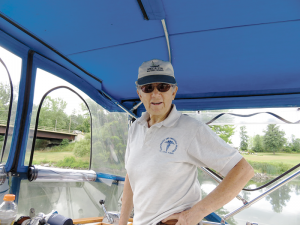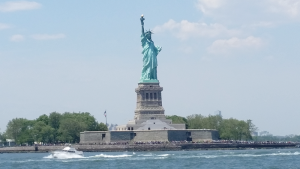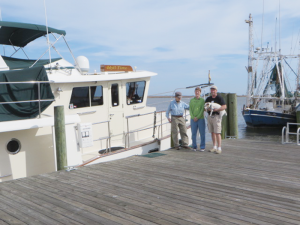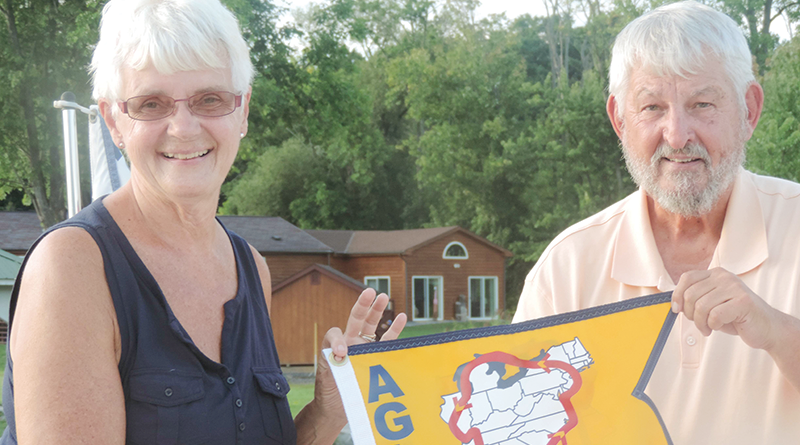The Great Loopers
Retirees spend about a year navigating through The Great Loop, a continuous waterway of about 6,000 miles in the US and Canada
By Mary Beth Roach

A sense of wanderlust and the desire to travel propelled Mike Sprik and Betty Carlisle to pilot their respective trawlers through The Great Loop, a continuous waterway of about 6,000 miles through the eastern portion of North America and part of the country’s heartland.
Traveling on his trawler Mosey III, Sprik began in May 2015 and wrapped up his Great Loop trip earlier this summer. He had navigated about 13 months, by the time he returned to his home dock on the Seneca River, near Baldwinsville.
Aboard her trawler, Sandpiper, Carlisle, a Brewerton resident and physician, now 78, began her adventure on the Great Loop in July 2014, and completed it 51 weeks, a week shy of a one year. She estimated that her route was about 7,000 miles.
From Lake Michigan To CNY
Having grown up near Lake Michigan, Sprik said he was always fascinated by boating. “We used to sit on the channel wall in Holland and watch the boats go by,” he recalled.
Fast forward a few decades, and now Sprik, 73, pilots his boat and watches the cities go by. He has even opted to live on the trawler on the Seneca River.
When Sprik began contemplating his retirement plans, he said he knew he wanted to travel. Originally he thought about getting a Winnebago motor home and joining an organization called Work Campers. While traveling, the campers stay at campsites, work there for a small stipend and get a free campsite in return. But then, Sprik heard about The Great Loop, and the idea appealed to the sailor in him. “’This sounds like the ultimate cruise,’” he recalled.
Although he grew up in Michigan, Sprik had moved to the Rochester area to attend the University of Rochester, stayed there after college, and spent his career in the banking industry.
“When I was working for Marine Midland in Rochester, I was in an auto dealers golf outing,” he said. “I was on the tee box and I had sliced about six balls into the nearby cornfield.” One of his fellow golfers said, “’Mike, want to improve your golf game, buy a boat.’”
It was a joke, Sprik said, but he found himself considering his friend’s idea. Living in Rochester near Lake Ontario and close to the Finger Lakes, Sprik said he bought a 1966 all-wood Chris-Craft and spent the next few seasons cruising the area waterways. In 1990, he moved to the Syracuse area, built a house in Cleveland on Oneida Lake, bought and traded two boats, and spent 15 years learning how to handle the boat solo.
He started making plans to do the Great Loop in 2013, and had anticipated taking off in 2014, but while waxing Mosey II, he slipped, and landed on his back. That injury resulted in a delay in his departure date. But he continued planning — visiting the Great Loop website of America’s Great Loop Cruisers’ Association — www.greatloop.org — figuring out budgets, and looking for a seaworthy trawler up to the task. About the boat he finally purchased, he said, “you see the world at 7-1/2 miles an hour, but that’s where the name Mosey comes from.”
So in May 2015, he began his adventure along with buddy and former writer for the Syracuse Post-Standard Frank Brieaddy. While Sprik had several crewmembers with him throughout the journey, the one who traveled the longest stretches with him was Sandy Pyne. She grew up with Sprik and was even his date for his senior prom in 1961. They reconnected about six or seven years ago, after one of his granddaughters saw them in photos from their high school days and encouraged him to find Pyne through Facebook.
Pyne may have come on board the Mosey III as a visitor, but after a harrowing, white-knuckled four-hour trip on Lake Michigan, fighting waves, some of which Sprik estimated at 6 to 7 footers, Pyne was promoted to “able-bodied seaman.” Once they anchored for the evening, and they were relaxing with some “docktails,” she announced that she wanted to stay on the cruise for longer periods of time. She has gone onto to earn the title first mate. “I even have a T-shirt and jacket to prove it,” she chuckled.
Sprik has chronicled this part of their adventure and others in his blog, “Cruising with Captain Mike,” which can be found at www.moseyiii.blogspot.com. One of the most interesting aspects of the trip for Sprik was seeing some of the big cities from the water, like Buffalo, Cleveland, Detroit and Chicago. “Most people never get to see these cities from that perspective,” he said.
While some Loopers opt to do the trip in stages, Sprik decided to do it all at one time and planned for about 13 months, giving himself and his crew time stop and visit various areas, make trips to visit family during the holidays, and of course, wait out bad-weather days.
And Sprik and Pine made sure to savor as much of the ambience of the various regions as possible. Some of their points of interest included the architecture and engineering feats in and around the Sanitary Canal in Chicago, the drawbridges and the 120 locks along the route; and the zydeco bands and the “Rent a Bum” in New Orleans. Also entertaining was Fern at Hoppies on the Mississippi. Fern is a classic, according to Pyne. She and her husband, Charles “Hoppie” Hopkins, own Hoppies, which is two retired barges wired together and then wired to the shore, Sprik said. It is a landmark for Loopers since it’s the last gas stop for the long stretch down the Mississippi and up the Ohio River to connect to the Tennessee–Tombigbee river system.
Fern holds daily briefings at 6 p.m. and tells the boaters what they can expect going down the Mississippi to the Tenn-Tom. And there was plenty of history to take in, like George Washington’s purchase of an area known as Dismal Swamp near North Carolina and Virginia, which Pyne said is anything but dismal; and of course, the other loopers they met along the way, who would offer suggestions, advice, and the unique friendship that comes from sharing an experience like traveling the loop.

As they started up the Atlantic Intercoastal Waterway, the pair took their time, not wishing for this trip to end, coasting by Asbury Park, where Sprik admitted to looking, albeit unsuccessfully, for Bruce Springsteen, one of that town’s favorite sons, and up to the busy New York Harbor, which Pyne found understandably a little intimidating, passing Ellis Island and stopping to visit some landmarks in that area. Eventually, they wound their way back to the Seneca River, where they have begun planning their next voyage.
A Lifelong World Traveler
“I think I started my wandering at 2,” joked Betty Carlisle. She was told that at about that age, she roamed away from home and was found about a mile from her house. While she was young, she and her family moved between Uruguay and the United States twice, and she graduated from high school in Uruguay. She has lived in the Los Angeles area, in Europe, Hawaii and Seattle, and even spent some time in Antarctica in the early 1990s. She saw an ad in a medical journal for a doctor to go to the South Pole, and she applied. She was the physician for the researchers and support staff there and had the opportunity to assist in some of the research.
Carlisle is fond of saying “have stethoscope, will travel,” and she said she is fortunate to have a job that allows her to go places and still work.
She got her start in navigation while in southern California. While interning at the Los Angeles County Hospital many years ago, she would take books from the library on how to sail, then head to the beach and practice what she read. After her internship year, she bought a 24-foot sailboat. She also took a power squadron class in seamanship and piloting.
When she was 50 years old, she had a cancer scare, and although the mass she had was not cancer, she decided to take a year’s sabbatical and she took off, sailing from Washington state to Baja to Mexico and the Sea of Cortez.
So she is no stranger to the water, to be sure.
In July 2014, Carlisle was ready to travel the Great Loop adventure, starting out with one crewmember, the son of a co-worker named John Alden, and although Alden went back to terra firma in Mississippi, Carlisle continued, easily finding enthusiastic crewmembers among friends and family along the way. But her one constant companion was her dog, Pepa. When asked what kind of dog Pepa is, she replied without hesitation, “stubborn.”
Carlisle’s route took her from Oneida Lake to Oswego, then Lake Ontario to Canada to Trent Severn to Lake Huron to Georgian Bay and North Channel also in Lake Huron. From there, she navigated the Sandpiper underneath the Mackinaw Bridge through Michigan then down to Milwaukee, through Chicago via the Calumet River to the Illinois River, then the Mississippi to the Ohio River to Tennessee and the Kentucky River and Kentucky lakes. From there it was on to Green Turtle Bay, with a side trip up the Cumberland and Nashville.
Carlisle was pleasantly surprised at how easy it was to pull up at the city docks at the end of the main street and spend several days, enjoying the sights and sounds of that city.
From there it was back down to Kentucky Lake and the Tennessee River, which lead them to the Tenn-Tom and Mobile, Ala. A stop at the Dog River Marina, then off again to Ocean Springs, Miss., where she was joined by her niece Gabriela Van Auken, who accompanied her on the Gulf Intercoastal Waterway to Apalachicola, Fla. A week of bad weather hampered their progress, but eventually they were able to do a night crossing to Clearwater, Fla., and traveled down the Gulf Coast to Marathon, Fla., where she decided to stay through the winter. When spring came, Carlisle was back on the water, with some friends, who would go up the Eastern Intercoastal Waterway and eventually to Norfolk, Va. The next leg would have her soloing, from Chesapeake to the Hudson River, although she “buddy boated,” so she knew if she got into trouble, help would be nearby. There she was joined by another friend, and they traveled the last leg through the Mohawk River and Valley to Sylvan Beach and back to Brewerton.
Like Sprik, Carlisle started a blog —https://sandpipertravels.wordpress.com — with details on the sights, sounds and cuisine along the way. Several spots really stood out to her. Like Sprik and Pyne, she commented on the unique vantage point from the waterways.
“Seeing the states from the rivers is an interesting perspective,” she said.
One of her favorite memories was the night passage across Lake Michigan from Muskegon, Mich., to Milwaukee, with the moon’s reflection on the water as her guide. “It was like following the Yellow Brick Road,” she said. Throughout her travels, she commented on how surprised she was to see the amount of commerce still on the rivers, and found the long stretches of sea grass in the Low Country of the Carolinas to be “hauntingly beautiful,” she said.
But more than the vistas, it was the people she met along the way.
The success of this trip is mainly people — the kindness of people along the Loop, she said.
“People overall are good,” she said. “ The trip allows you to slow down and see people as human beings.”
She looks forward to the opportunity to do the Loop again, spending more time exploring the side rivers.
The Great Loop
 The circumnavigation of Eastern North America by water is known as the Great Loop. Also referred to as America’s Great Loop and the Great Circle Route, the trip varies from 5,000 to 7,500 miles depending on route options and detours taken. The boats used range from personal watercraft to 60-foot-long yachts.
The circumnavigation of Eastern North America by water is known as the Great Loop. Also referred to as America’s Great Loop and the Great Circle Route, the trip varies from 5,000 to 7,500 miles depending on route options and detours taken. The boats used range from personal watercraft to 60-foot-long yachts.
Both sailboats and powerboats travel the loop, but the most common boats are 34–45-foot recreational trawlers.
The main factors that govern the size of the boats are the limited draft (5 feet) in some locations on the loop and the height of one bridge (19 feet) in Chicago.
People traveling the Great Loop are known as “loopers”. The number of people attempting this voyage is growing as baby boomers reach retirement age.
Source: Wikipedia
- To learn more about the The Great Loop, visit website of America’s Great Loop Cruisers’ Association, www.greatloop.org
- To learn more about Mike Sprik’s adventures, check the blog “Cruising with Captain Mike,” which can be found at www.moseyiii.blogspot.com.
- Betty Carlisle’s blog with details on the sights, sounds and cuisine along her way though the loop, can be found at
https://sandpipertravels.wordpress.com

